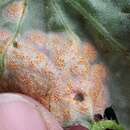pt-BR
nomes no trilho de navegação


Puccinia poarum ist eine Ständerpilzart aus der Ordnung der Rostpilze (Pucciniales). Der Pilz ist ein Endoparasit von Korbblütlern sowie von zahlreichen Süßgräsern. Symptome des Befalls durch die Art sind Rostflecken und Pusteln auf den Blattoberflächen der Wirtspflanzen. Die Art kommt in Eurasien und Amerika vor.
Puccinia poarum ist mit bloßem Auge nur anhand der auf der Oberfläche des Wirtes hervortretenden Sporenlager zu erkennen. Sie wachsen in Nestern, die als gelbliche bis braune Flecken und Pusteln auf den Blattoberflächen erscheinen.
Das Myzel von Puccinia poarum wächst wie bei allen Puccinia-Arten interzellulär und bildet Saugfäden, die in das Speichergewebe des Wirtes wachsen. Die Aecien der Art besitzen 20–27 × 18–24 µm große, breitellipsoide bis kugelige und hyalin-gelbliche Aeciosporen. Die hell orangegelben Uredien der Art wachsen oberseitig auf den Blättern der Wirtspflanze. Ihre hellgelben bis fast farblosen Uredosporen sind für gewöhnlich ellipsoid bis eiförmig, 23–30 × 17–24 µm groß und fein stachelwarzig. Die blattunterseitig wachsenden Telien der Art sind lange bedeckt. Die gold- bis haselnussbraunen Teliosporen des Pilzes sind ein- bis zweizellig, in der Regel lang zylindrisch bis eiförmig und 40–58 × 17–25 µm groß. Ihr Stiel ist gelblich bis farblos und bis zu 15 µm lang.
Das bekannte Verbreitungsgebiet von Puccinia poarum reicht Europa über Asien und Nordamerika bis nach Südamerika.
Die Wirtspflanzen von Puccinia poarum sind für den Haplonten Korbblütler (Asteraceae spp.) sowie Süßgräser (Poaceae spp.) für den Dikaryonten. Der Pilz ernährt sich von den im Speichergewebe der Pflanzen vorhandenen Nährstoffen, seine Sporenlager brechen später durch die Blattoberfläche und setzen Sporen frei. Die Art verfügt über einen Entwicklungszyklus mit Telien, Uredien, Spermogonien und Aecien und macht einen Wirtswechsel durch.
Puccinia poarum ist eine Ständerpilzart aus der Ordnung der Rostpilze (Pucciniales). Der Pilz ist ein Endoparasit von Korbblütlern sowie von zahlreichen Süßgräsern. Symptome des Befalls durch die Art sind Rostflecken und Pusteln auf den Blattoberflächen der Wirtspflanzen. Die Art kommt in Eurasien und Amerika vor.
Puccinia poarum, the coltsfoot gall rust[1] or meadow grass rust, is a plant pathogen. This fungal parasite forms a yellow to orange gall, 1–2 cm in diameter, on the underside of leaves of coltsfoot (Tussilago farfara).[2] It also infects, but does not gall grasses of the family Poaceae.[3] P. poarum is a genetically diverse species that has been reported on at least seventy plant hosts.[4]
On Tussilago farfara (coltsfoot), infection by P. poarum results in large, circular, yellow or orange-red spots that protrude from the undersides of the leaves,.[5][6] The spots often have a purple margin[2] and sometimes a central hole. On the lower leaf surface, 20-30 cup-shaped aecia of the fungus form on each gall.[1] On the upper surface of the leaf, infection results in a yellow circle with no swelling. Spermogonia) may also be present.[5] On T. farfara the rust is necrotrophic, obtaining nutrients from dead cells and tissues of the plant.
Puccinia poarum may be confused with a different rust on T. farfara (coltsfoot), Coleosporium tussilaginis. Coleosporium tussilaginis usually appears later in the season, does not form galls or aecia, but instead forms diffuse uredinia with powdery orange spores on the lower leaf surface; it is less obvious on the upper leaf surface[7] and lacks the purple margin[2] and central hole characteristic of P. poarum.
Puccinia poarum completes its life cycle on two different plant hosts: It forms spermagonia and aecia on Tussilago farfara (coltsfoot), and uredinia and telia on the leaves of a grass in the family Poaceae. Its life cycle is similar to that of Puccinia striiformis. Peter Nielsen was the first to describe the heteroecious life-cycle of this fungus.
In the United Kingdom this rust is locally common[5] and widely distributed.[8] Northern hemisphere to South America.[9]
Puccinia poarum, the coltsfoot gall rust or meadow grass rust, is a plant pathogen. This fungal parasite forms a yellow to orange gall, 1–2 cm in diameter, on the underside of leaves of coltsfoot (Tussilago farfara). It also infects, but does not gall grasses of the family Poaceae. P. poarum is a genetically diverse species that has been reported on at least seventy plant hosts.
Puccinia poarum Nielsen – gatunek grzybów z rodziny rdzowatych (Pucciniaceae)[1]. Jest szeroko rozprzestrzeniony w Ameryce Północnej i Europie, występuje także w Azji i Australii[2]. Grzyb mikroskopijny, pasożyt obligatoryjny wielu gatunków roślin[3].
Pozycja w klasyfikacji według Index Fungorum: Puccinia, Pucciniaceae, Pucciniales, Incertae sedis, Pucciniomycetes, Pucciniomycotina, Basidiomycota, Fungi[1].
Jest to pasożyt dwudomowy, czyli taki, który dla pełnego cyklu rozwojowego potrzebuje dwóch gatunków roślin żywicielskich: część rozwoju odbywa na liściach podbiału pospolitego, część – na licznych gatunkach roślin z rodziny wiechlinowatych (Poaceae)[3].
Podbiał pospolity zakażany jest przez zarodniki zwane sporydiami, które wnikają przez aparaty szparkowe do tkanek jego liści. Rozwija się z nich grzybnia odżywiająca się tkankami gospodarza i powodująca ich nekrozę. W okresie od maja do czerwca na dolnej stronie liści powstają rdzawe lub pomarańczowo-czerwone okrągławe plamy o średnicy 1-2 cm. Znajduje się w nich około 20-30 ecjów tworzących pierścień[5]. Czasami powstaje wokół nich fioletowy pierścień, a w środku plamy centralny otwór. Na górnej powierzchni liścia nad ecjami powstaje żółta plama ze spermogoniami[6].
Na liściach podbiału występuje także grzyb Coleosporium tussilaginis, który również na ich dolnej stronie tworzy pomarańczowe plamy. Pojawiają się one jednak w sezonie wegetacyjnym później niż Puccinia poarum, nie są tak okrągłe i nie tworzą tak dobrze wyodrębnionych klastrów, lecz zazwyczaj duże plamy, często zlewające się[7].
Puccinia poarum Nielsen – gatunek grzybów z rodziny rdzowatych (Pucciniaceae). Jest szeroko rozprzestrzeniony w Ameryce Północnej i Europie, występuje także w Azji i Australii. Grzyb mikroskopijny, pasożyt obligatoryjny wielu gatunków roślin.
Puccinia poarum je grzib[5], co go ôpisoł E. Nielsen 1877. Puccinia poarum nŏleży do zorty Puccinia i familije Pucciniaceae.[6][7] Żŏdne podgatōnki niy sōm wymianowane we Catalogue of Life.[6]
Puccinia poarum je grzib, co go ôpisoł E. Nielsen 1877. Puccinia poarum nŏleży do zorty Puccinia i familije Pucciniaceae. Żŏdne podgatōnki niy sōm wymianowane we Catalogue of Life.